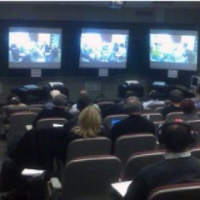Trial Presentation Simplifying Complex Evidence for Jury Understanding
Trial Presentation Simplifying Complex Evidence for Jury Understanding
Blog Article
Mastering Test Discussion: Tips for Engaging and Persuasive Court Techniques
In the world of trial discussion, the ability to involve and encourage is paramount. The obstacle lies in effortlessly incorporating them right into a natural presentation. What techniques can genuinely elevate a trial presentation from common to remarkable?
Understanding Your Audience
To successfully master test discussion, it is critical to understand your audience. Understanding their demographics, backgrounds, and possible prejudices can assist customize your discussion to resonate with them effectively.

A recognition of the court's preferences and courtroom rules is just as crucial, as it can affect the flow of your discussion. Judges might prioritize brevity and quality, so providing your instance in a straightforward manner can enhance your reliability. Additionally, acknowledging the opposite guidance's methods can assist in preparing counterarguments that effectively resolve their factors.
Eventually, comprehending your target market allows you to engage them better, cultivating connection and persuasion throughout the trial (trial presentation). By leveraging insights regarding their motivations and assumptions, you can create an engaging discussion that resonates and inevitably influences the outcome of the instance. This foundational expertise is essential for any lawyer intending to accomplish success in the court room
Crafting an Engaging Narrative
A well-crafted story functions as the backbone of an effective trial presentation, guiding the target market with the intricacies of the case. This story needs to be structured to involve jurors psychologically and intellectually, making the facts relatable and easy to understand. By weaving with each other the aspects of the case-- such as the timeline, essential occasions, and crucial testaments-- attorneys can develop a coherent storyline that reverberates with jurors.
To achieve this, it is necessary to determine the main themes that will certainly drive the narrative. Attorneys must concentrate on the motivations and objectives of the parties involved, showing the human aspects of the situation (trial presentation). This strategy not just keeps juror rate of interest yet likewise fosters compassion, leading them to connect directly with the story
In addition, using clear and concise language is crucial. Avoiding lawful jargon allows the target market to realize the crucial points without confusion. Each sector of the narrative need to build toward a compelling orgasm, culminating in a persuasive final thought that reinforces the instance's core message. Eventually, a strong story not just clears up the concerns available but likewise produces an enduring perception that can affect the end result of the trial.
Utilizing Visual Aids Effectively
Just how can visual aids improve the performance of a test presentation? Visual help serve as effective tools that can substantially improve juror understanding and retention of complicated information - trial presentation. When used attentively, they can make clear key factors, highlight connections, and emphasize important evidence that supports the instance story
Reliable visual help consist of graphes, charts, timelines, and images, which can simplify complex data and provide context. For circumstances, a timeline can succinctly share the series of events, while a graph can highlight analytical details in an aesthetically engaging way. The critical use of multimedia discussions can also improve interaction and see this preserve juror passion throughout the test.
Furthermore, visual aids can assist to evoke emotional actions, strengthening the human elements of an instance. By providing advice photos or video clips appropriate to the instance, lawyers can develop an extra compelling and relatable narrative. It is necessary to make sure that aesthetic aids are properly developed and not overly intricate, as this can lead to confusion instead than clearness.
Engaging Body Movement Techniques
Aesthetic aids are not the only devices that can enhance the performance of a trial presentation; engaging body language techniques additionally play a crucial role in recording juror attention and sharing confidence. A presenter's nonverbal signs can dramatically affect jurors' perceptions and reactions, making it necessary to grasp these techniques.

Furthermore, differing your vocal tone and speed can enhance your storytelling, making it more compelling. Stopping briefly purposefully allows jurors to absorb vital info and indicates the importance of what you are saying. Last but not least, relocating purposefully within the court room can aid strengthen your factors, gave it does not distract from your message.
Including these body movement methods will certainly not only enhance your court visibility yet additionally foster a more convincing link with jurors, ultimately adding this contact form to the success of your test presentation.
Exercising for Impact
Efficient test presentations hinge not just on the material however additionally on the shipment, making method necessary for impact. The relevance of rehearsal can not be overemphasized; it enables lawyers to refine their disagreements and establish a powerful visibility in the courtroom. Engaging in deliberate practice aids attorneys to identify their toughness and weaknesses, enabling them to change their pacing, tone, and body movement as necessary.
To exercise for effect, mimic trial problems as carefully as feasible. This includes using aesthetic help, practicing before associates, and obtaining constructive comments. Recording session can also supply important understandings into distribution design and target market interaction. Concentrate on quality in speech, ensuring that complex legal principles are communicated successfully to the court.

Final Thought
Mastering trial discussion entails a multifaceted approach that integrates audience understanding, narrative growth, aesthetic aids, and body movement. These components function synergistically to create an influential court room experience. By successfully engaging jurors with clear narration and impactful visuals, and by employing positive body movement, trial supporters can dramatically enhance their disagreements. Strenuous practice in simulated settings further solidifies these techniques, ensuring that each presentation reverberates and leaves a long-term impression on the court.
Report this page